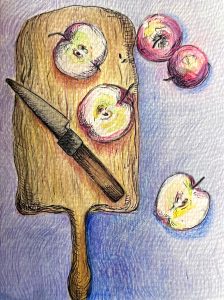Mentoring at an island marine lab
By Karly Cohen
This summer I took part in the REU (Research Experiences for Undergraduates) mentorship program at Friday Harbor Labs. This mentorship project has left a significant footprint during the summers at Friday Harbor since 2009. Undergraduate students from across the country can apply and are then matched up with mentors to explore questions about development, evolution, ecology, and mechanics. These research experiences have been instrumental in the professional development of students for years and I am excited to have been a part of it. My student and I explored the diversity of teeth in deep-sea fishes. These fishes have an impressive diversity of dentitions from large commanding fangs to jaws filled with teeth. Our goal was to CT scan and use scanning electron microscopy (SEM) to understand 1) if the teeth of deep-sea fishes are different depending on diet, 2) is this relationship highlighted by differences in sharpness, and 3) does a deeper understanding of tooth morphology in deep-sea fishes clarify trophic interactions? Understanding the food web of deep-sea fishes is hard work, there are almost no opportunities to observe direct trophic interactions and so we are left with morphology and diet content.
Sharpness is a morphological measure that directly relates to the puncturing performance of teeth. We hypothesized that species found with fishes in their guts will have sharper teeth compared to individuals that feed on zooplankton. Unfortunately for us, sharpness is heavily influenced by size and our results were inconclusive. But what we did find lead us down a new and exciting route to connecting teeth and diet. Each species we looked at had grooves, serrations, and damages that are far more indicative for how the teeth are being used than sharpness alone. We were only able to find these patterns using SEM. We may not yet understand how teeth fit into the larger trophic interactions of the deep, but this project brings us one step closer in identifying what aspects of tooth morphology are important when considering the evolution, behavior and functions of dentitions. My student and I will be presenting this work (with the addition of some new species) in January at the annual SICB meeting in Austin Texas.
After the REU program I embarked on another journey. My colleague, Kate Bemis, and I hosted a histology workshop at Friday Harbor labs funded through the Company of Biologists and Gans Collection and Charitable funds. Participants came from seven institutions across the United States and one from Brazil. Over the course of the workshop, participants learned techniques including sectioning, staining, and visualizing; practicing first on test specimens, and then working on their own specimens. The workshop was bigger than we could have hoped for, chaotic, and lots of work but all of our participants left with data and a new skill set they could bring back to their labs and institutions. Several participants already are continuing to use histology for their own work.
Karly is a 2nd year PhD student in Adam Summers’ lab





